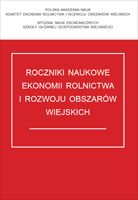Main Article Content
Article Details
Belyalov T., Oliynyk A. 2016: Enterprise financial stability and ways of its strengthening. International Scientific Journal “Internet Science”, Vol. 12 (22), part 2, p. 22-26.
Breitschuh G., Eckert H., Matthes I., Strümpfel J., Bachmann G., Breitschuh T. Kriteriensystem Nachhaltige Landwirtschaft (KSNL). Available online: https://www.ktbl.de/fileadmin/produkte/ leseprobe/11466excerpt.pdf (accessed on 9 August 2018).
Brentano L. 2012: Agrarian Reform in Prussia. Publ. Rarebooksclub.com, p.78.
Caldari K. 2004: Alfred Marszall’s idea of progress and sustainable development. The History of Economics Society, Vol. 4, p. 519-536.
Daly H. 1996: Beyond Growth: The Economics of Sustainable Development. Boston, Beacon, p. 264.
Davydenko N. 2009: Financial sustainability of the corporate enterprise of agrarian sphere. Actual problems of the region’s economy development: Scientific collection of the Precarpathian National University named after. Vasyl Stefanyk. Part.2, p.110-116.
Endrikata Edeltraud, J., Holger Hoppec, G. 2014: Making sense of conflicting empirical findings: A metaanalytic review of the relationship between corporate environmental and financial performance. Eur. Manag. J., 5, p. 735-751.
François Q., Kuczynski M., Meek R. L. 1972: Quesnay’s Tableau eìconomique. London, Macmillan; New York, A.M. Kelley for the Royal Economic Society and the American Economic Association.
Grenz J. 2017: Response-Inducing Sustainability Evaluation (RISE); Bern University of Applied Sciences: Bern, Switzerland, p. 9.
https://www.clubbenchmarking.com/blog/measuring-financial-sustainability.
Jollands N., Lermit J. Patterson M. 2003: The Usefulness of Aggregate Indicators in Policy Making and Evaluation: A Discussion with Application to Eco-Efficiency Indicators in New Zealand. Available online: https://openresearch-repository.anu.edu.au/handle/1885/41033 (accessed on 15 August 2018).
Keynes J.M. 1936: The General Theory of Employment, Interest and Money. Macmillan Cambridge University Press, p. 263.
Keynes J.M. 1973: The General Theory and After: Part I. Preparation, in the Collocted Writings of John Maynard Keynes, Vol. XIII, ed D. Moggridge. Macmillan Cambridge University Press, p. 669.
León Patricia 2001: Four pillars of financial sustainability. The Nature Conservancy, Arlington, Virginia, USA, p.29.
Marshall Alfred 1890: Principles of Economics (8th ed.). The Online Library of Liberty, p. 627.
Marx Karl 1967: Capital III International. Publishers: New York, p. 645.
Mateoc-Sîrb N., Otiman P., Raicov M. 2010: Simpozion Institutul de Economie Agrară, Vol. Economie Agrară şi Dezvoltare Rurală, Editura Academiei Române, Bucureşti, ISSN 1584-5761.
Mocanu N. 2012: Identification of the main directions of the agrarian sector, In: Management agricol: Simpozionul Ştiinţific Internaţional. Timişoara, vol. 14 (1), p. 127-132.
Nardo Michela and others 2008: Organisation for Economic Co-operation and Development, Joint Research Centre of the European Commission. Handbook on Constructing Composite Indicators: Methodology and User Guide; OECD Publishing: Paris, France.
Neumann J., Morgenstern O. 1944: Theory of Games and Economic Behaviour. Princeton University Press, p. 776.
Parastoo S., Saudah S., Parvaneh S., Sayyedeh S., Saeidi Seyyed P., Saaeidi A. 2015: How does corporate social responsibility contribute to firm financial performance? The mediating role of competitive advantage, reputation, and customer satisfaction. J. Bus. Res. 2, p. 341-350.
Riikkinen R., Kauppi K., Salmi A. 2017: Learning Sustainability? Absorptive capacities as drivers of sustainability in MNCs’ purchasing. Int. Bus. Rev., 26, p. 1075-1087.
Scheuerlein A. 1997: Finanzmanagement für Landwirte: Beispiele, Anwendungen, Beurteilungen; BLV-Verl.-Ges.: München, Germany, p.247.
Singh P.J., Sethuraman K., Lam J.Y. 2017: Impact of Corporate Social Responsibility Dimensions on Firm Value: Some Evidence from Hong Kong and China. Sustainability 9 (9), 1532. https://doi.org/10.3390/su9091532
Smith A. 2008: Inquiry into the Nature and Causes of the Wealth of Nations, Volume II. Publ. BiblioLife, p. 496.
Sun W., Louche C., Pérez R. 2011: Finance and Sustainability: Towards a New Paradigm? A Post-Crisis Agenda; Emerald Group Publishing: Bingley, UK, pp. 4-6, ISBN 978-1-78052-092-6.
Walras L. 1984: Elements of Pure Economics, or The Theory of Social Wealth. Orion Editions, p. 620.
Wasilewska Natalia, Kruchok N. 2010: Estimation of the Financial State of Agrarian Enterprises in Ukraine. „Zeszyty Naukowe Szkoły Głównej Gospodarstwa Wiejskiego w Warszawie. Ekonomika i Organizacja Gospodarki Żywnościowej, Vol 81, p. 41-53.
Wicki, Ludwik, Mykola Orlykovskyi, Lesia Zaburanna 2017: Agriculture in Poland and Ukraine – Potential and Dynamics of Changes in Production. Zeszyty Naukowe SGGW w Warszawie - Problemy Rolnictwa Światowego, 17(32) (4), s. 326-338. https://doi.org/10.22630/PRS.2017.17.4.108
Young M.L. 2018: State of Sustainable Business Practices for Small and Midsized Businesses: Why Some SMEs Implement Sustainable Business Practices and Some Do Not. Available online: http://www.manifestmind.com/wp-content/uploads/State-of-Sustainable-Business-Practices-for-SMEs.pdf (accessed on 12 January 2018).
Zakharchenko V. 2012: Models and methods of decision making in analysis and audit: [curriculum. manual]. Lviv: Magnolia-2006, p. 325.
Zhao H., Zhang F., Kwon J. 2018: Corporate social responsibility research in international business journals: An author co-citation analysis. Int. Bus. Rev. 27, p. 389-400.
Zhuravleva O. 2009: Financial stability of the enterprise: theory and practice. Formation of a market economy. Collection of scientific works. Vol. 22, p. 523-536.
Zorn A., Esteves M., Baur I., Lips M. 2018: Financial Ratios as Indicators of Economic Sustainability: A Quantitative Analysis for Swiss Dairy Farms. Sustainability, 10(8), 2942. https://doi.org/10.3390/su10082942
Downloads
- Mirosława Witkowska-Dąbrowska, Wyposażenie obszarów wiejskich w systemy odprowadzania ścieków na przykładzie gmin powiatu olsztyńskiego , Roczniki Naukowe Ekonomii Rolnictwa i Rozwoju Obszarów Wiejskich: Tom 105 Nr 1 (2018)
Możesz również Rozpocznij zaawansowane wyszukiwanie podobieństw dla tego artykułu.




